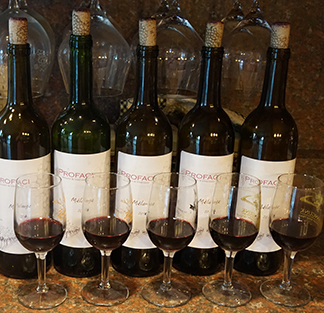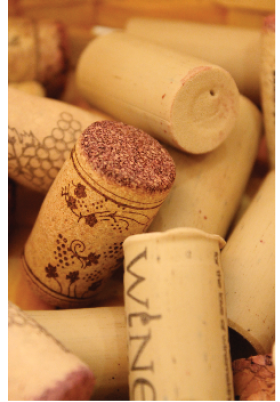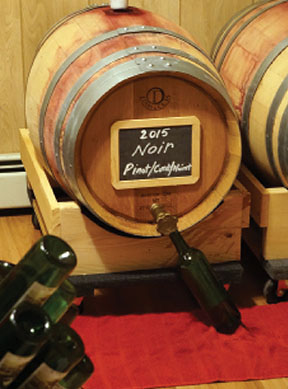 What is bottle variability? Well, let’s start with what bottle variability isn’t. Not to be silly, but bottle variability doesn’t have to do with different types of bottles; at least not in the context of this article.
What is bottle variability? Well, let’s start with what bottle variability isn’t. Not to be silly, but bottle variability doesn’t have to do with different types of bottles; at least not in the context of this article.
It is not tasting a bottle of wine today and then tasting it again the next day and it seemingly tasting different. The change in flavor and aroma of a bottle of wine from one day to the next is most commonly an issue associated with a change in one’s palate versus a change in the wine itself. Many things can change someone’s palate — from the onset of a cold, what they eat or drink prior to tasting the wine, or even the mood they are in. Yes, a person’s mood and surroundings can change one’s perception of the wine they are tasting.
It is not tasting a bottle of wine today and enjoying it, then putting it in your cellar and letting it age for 6 months, 1 year, 2 years, or 10 years. The wine will inevitably taste different. Wine is a “living liquid.” Wines, especially reds, go through phases of life. It is either evolving, at its peak or plateau, or devolving. This life cycle is different from one wine to another; along with a tremendous number of variables in that wine’s handling and storage, that are well beyond the scope of this article.
So what is bottle variability? Let’s say you take five bottles of the same wine, open all those bottles, and taste them individually all at the same time. What might you find? You may find that two of those bottles taste exactly the same, one bottle may taste completely off, while the other two bottles don’t taste off but are definitely different in flavor, aroma, or character than the first two and possibly from each other. This is bottle variability. Many times you may hear a wine drinker make the comment “that’s a good bottle.” Knowing it or not, the wine drinker is referring to the phenomenon known as
bottle variability.
So why is this a big deal? Let’s assume you are a commercial winery for a moment. You have wine tastings of your wines and someone really loves your Cabernet Franc. They like it so much that they buy a case. Now they go home and open a bottle with dinner and it doesn’t taste as good as they remember it. Let’s chalk that up to what they were eating. They’re having such a nice time with family and friends that they open a second bottle and that one tastes completely different, even a bit off. They don’t like that one at all. So they open a third and again this one tastes different to the other two. What does this lead the consumer to think? It may give them a negative impression of that winery and they may not return. Bad for business.
For the home winemaker, we are just worried about pleasing our own palates as well as our friends and family. You could have the same exact scenario as previously described with your own wines. How would that make you feel after spending so much of your time and paying such close attention to nurturing and creating the best wine you could? It happens. Unfortunately, it happens all too often.
Bottle Variability Causes
So what causes bottle variability and how can we protect against it? I should probably start by defining what the same wine is. The same wine, in this context, is one made from the same grapes, the same vintage, by the same winemaker, put through the same processes, in the same environmental conditions prior to bottling. And if you are a winemaker who makes larger batches that may not have the storage capacity to bulk age the entire batch together (i.e. large stainless steel tank, demijohn, barrel, or the like) and you end up aging the batch in individual carboys, you will need to blend those carboys to get overall uniformity in your batch. Remember, every one of those carboys is an environment of its own with somewhat different conditions that can easily cause variation in the final wine; believe it or not. I wanted to make this distinction as every wine is different. One year’s vintage will be completely different from another’s based on what Mother Nature and the wine grower provided for that year. Even grapes grown next door to each other in a slightly different strata of soil and microclimate can be very different in character. Now add to the mix two different winemakers and all bets are off, even when using the same grape from the same place at the same time. Wine is definitely a complex mixture of nurture and nature. However, we will assume that prior to bottling the batch of wine going into the bottles is exactly the same. So what are the potential causes of bottle variability?
1. Cleanliness of the bottles
How your bottles are cleaned and sanitized prior to bottling can lead to bottle variability. This is especially true for those that recycle and reuse wine bottles. Sometimes bottles are just too difficult to clean. Was the bottle left with wine and/or solid residue in it? These can be more work to clean and sanitize than they are worth, in my opinion. Any type of residue, visible or not, can lead to a variation in that bottle of wine. It is, in fact, in a different environmental condition for it to evolve. As such, its evolution will be different than the bottle sitting next to it on the shelf. The optimum solution here is to use new bottles from vintage to vintage, like the commercial wineries do.
This, however, can be a bit cost-prohibitive for us home winemakers. The other is to be very selective over the recycled bottles that are used and ensure those bottles are properly cleaned and sanitized prior to use. I personally use a solution of potassium metabisulfite and citric acid to sanitize each bottle just before bottling. I also rinse and air-dry every bottle prior to storage for the next season’s wines, at a minimum. Sometimes a bottle may have some residues that can be easily removed by filling the bottle with a percarbonate solution and allowing it to rest overnight. If this doesn’t work, I’d suggest sending that bottle to the recycling center. It’s not worth a spoiled bottle of your delicious wine.
2. Sulfite and Oxygen management
The bottling of wines can be a very traumatic time for the wine. The level of trauma is highly dependent on the method used in bottling. A winemaker can fill his/her bottles from a spigot on their carboy or barrel, use a vacuum bottling system, use a commercial-style gravity bottling system, or just a racking cane with a bottling wand. Each one of these methods will have varied impacts on how much oxygen is introduced into the wine at the time of bottling, along with other potential contaminants. This, depending on how much wine you are bottling and how consistent you are in your approach, can lead to bottle variability. To minimize this issue the winemaker must have a good handle on oxygen and contamination management. The best way to deal with this is through proper sulfite management prior to, and in preparation for, bottling.
If you want to keep sulfite additions to a minimum in your wines then you will need to invest in some analytical equipment in order to keep tabs on things and provide you data in order to make educated decisions with regards to your additions. Knowing your wine’s current levels of free and total SO2, pH, temperature, alcohol percent, and dissolved oxygen (DO) levels will provide excellent baseline data in determining the amount of potassium metabisulfite to add just prior to bottling. Again, the type of bottling method you utilize will impart more or less DO and potential contaminants to your bottled wine; so a bit of experience with your methods is important in determining the proper amount of sulfite to add without overdoing it.
If you don’t want to go through this effort or expense, you may have to err on the side of being conservative and use a higher dosage to make sure your wine is properly protected.
3. Closure type
Bottle closure variability is arguably the largest issue when it comes to bottle variability. This is especially true if utilizing natural cork-based closures. Natural cork has contaminants inherently in its makeup. It is, after all, made from the bark of a living tree. The one contaminant that causes the biggest concern with regards to bottle variability is 2,4,6-trichloroanisole, more commonly referred to as TCA. When a wine is referred to as “corked” it is due to TCA being at higher levels in the wine and can make the wine taste and smell moldy, musty, or like cardboard or wet newspaper.
Even at very low levels, TCA can lead to bottle variability. When one talks about perceptible levels of TCA, it is discussed in parts per trillion. Research in Europe and at UC-Davis have concluded that some tasters can detect and perceive TCA as low as 1 to 2 parts per trillion. At even lower levels it can change the characteristics and flavors of the wine. So as you can see, it doesn’t take much to create a problem. Like any other contaminant, it changes the environmental conditions in the bottle and can lead to the development of a different wine — typically one that is not as good as if there were no TCA. It can lead to fruit flavors and aromas of the wine being greatly dulled and muted. The wine can seem off and lacking in complexity, or in more severe cases it can make a wine completely undrinkable. For these reasons there has been a move to synthetic corks and screw caps. Theoretically, no cork means no TCA; although TCA can come from other parts of the winery based on its cleanliness and cleaning habits, but this is much less common.
For the traditionalist, however, these alternate types of closures have still not come into favor. Unfortunately, non-cork based closures are still perceived by the consumer as indicative of an inferior wine. Quality wines are still, for the most part, sealed with traditional corks. Supercritical corks do provide a solution to those that wish to continue to use cork as their closure of choice. Supercritical corks are agglomerated corks that utilize cork material that has been put through a process that completely removes TCA and other contaminants. Through the utilization of these corks, just like synthetic corks and screw caps, the potential for TCA contamination is eliminated from
the closure.
4. Bottle Storage
So now where to put all those bottles? The general rule is somewhere cool, dark, and humid. The optimal temperature described in literature is 55 °F (13 °C) and a humidity level of 70 percent. These are targets, however, and your storage doesn’t have to be exactly these; what is almost more important is that there be minimal swings in temperature and humidity in that space over a 24-hour period.
So where does the bottle variability come in? Well, let’s say you’re a home winemaker with limited storage space in your basement for all the wine you make. Now you’re forced to find different locations to store all your bottles. You pick what you think may be the best places you have available, but each one is slightly different. As noted earlier on, varied environmental conditions will cause bottle variability. This could be from contaminants in contact with the wine, as we’ve already discussed, but could also come through external environmental conditions that impact the internal conditions. Just a couple of degree difference in temperature from one storage area to the other, along with a variability in humidity, can change the evolution of that wine. Why? Well, with increased temperature comes increased reaction rates. The slightly warmer temperatures will accelerate all those reactions that are occurring in the bottle. This could be bad for your wine. Just like braising meat, wine evolution is best when it’s “low and slow.”
Varied humidity can take its toll because as humidity levels drop, the rate at which a natural cork closure allows for oxygen to enter the bottle increases. Here again, a change in the wine’s environmental condition that leads to bottle variability.
The last thing I’d like to add on this topic is related to a pet peeve of mine. By no means should you store your wines in your kitchen. This location provides for the worst possible storage conditions with high and very variable temperatures and relatively low humidity. Wine should only be in the kitchen when you are serving it to your friends and family.
In the end, your focus is to make the best wine you can each vintage. Once you feel like you have achieved that and you are ready to bottle, you want to ensure that each bottle is consistently as delicious as the last one. Yes, your wine can taste different based on its maturation and your palate at that instant of time, but you don’t want it to taste different due to improper bottling and bottle handling. Each of us as winemakers continues to learn and improve from vintage to vintage. We learn from past mistakes and gain knowledge from everything we do. We look to fully understand and perfect the processes we employ to make the best wines we can. We must not forget about taking the same level of care in our wines’ next stages of life.







